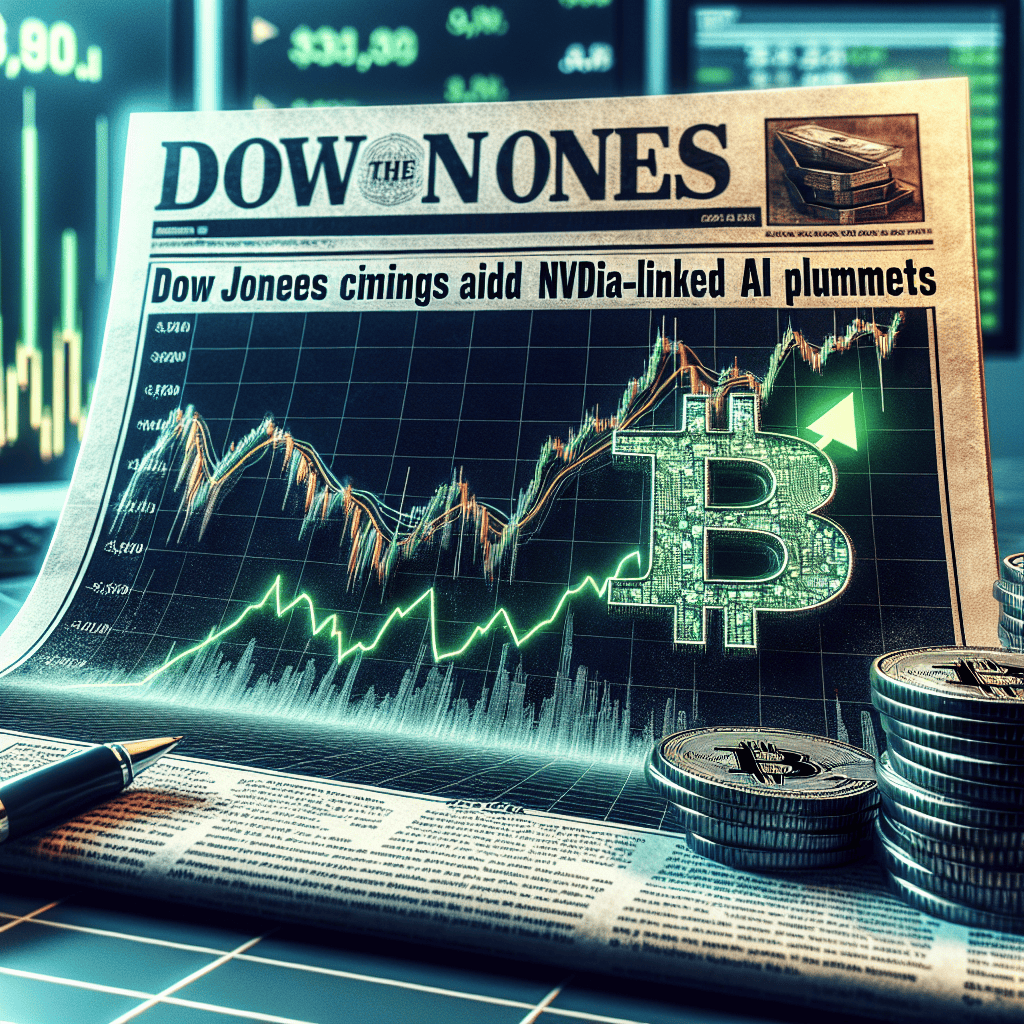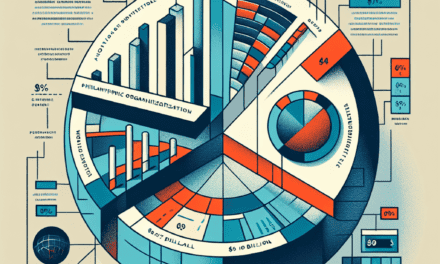“Market Rollercoaster: Dow Rises, Bitcoin Soars, Nvidia-Linked AI Stock Tumbles”
Introduction
The financial markets are witnessing a dynamic shift as the Dow Jones Industrial Average experiences a notable climb, coinciding with Bitcoin’s unprecedented surge to $92,000. This remarkable ascent in the cryptocurrency market is capturing the attention of investors worldwide, reflecting a growing confidence in digital assets. Meanwhile, in a contrasting development, a prominent AI stock linked to Nvidia is facing a significant downturn, highlighting the volatile nature of tech investments. These live updates provide a comprehensive overview of the current market landscape, offering insights into the factors driving these significant movements and their potential implications for investors.
Impact Of Bitcoin’s Surge On The Dow Jones
The recent surge in Bitcoin’s value to an unprecedented $92,000 has sent ripples through the financial markets, notably impacting the Dow Jones Industrial Average. This remarkable ascent in Bitcoin’s price has been attributed to a confluence of factors, including increased institutional adoption, heightened interest from retail investors, and a growing perception of Bitcoin as a hedge against inflation. As Bitcoin continues to capture the attention of investors worldwide, its influence on traditional financial markets, such as the Dow Jones, becomes increasingly evident.
The Dow Jones Industrial Average, a key indicator of the health of the U.S. stock market, has experienced a notable climb in response to Bitcoin’s surge. This upward movement can be partially attributed to the growing integration of cryptocurrencies into mainstream financial systems. As more companies and financial institutions embrace Bitcoin, either by holding it on their balance sheets or by facilitating its use in transactions, the correlation between Bitcoin’s performance and traditional stock indices like the Dow Jones becomes more pronounced. Consequently, the recent rise in Bitcoin’s value has contributed to a positive sentiment in the stock market, encouraging investors to take on more risk and driving up stock prices.
However, while the overall impact of Bitcoin’s surge on the Dow Jones has been positive, it is essential to consider the nuanced effects on individual stocks within the index. For instance, companies with direct or indirect exposure to cryptocurrencies have seen their stock prices benefit from Bitcoin’s rally. Financial institutions that have embraced digital currencies, such as those offering Bitcoin trading services or investing in blockchain technology, have experienced increased investor interest and, subsequently, a boost in their stock valuations.
On the other hand, the surge in Bitcoin has not been universally beneficial across all sectors. Notably, Nvidia-linked AI stocks have faced significant challenges amid this cryptocurrency boom. Nvidia, a leading player in the semiconductor industry, has been closely associated with the development of artificial intelligence technologies. However, the recent decline in Nvidia-linked AI stocks can be attributed to several factors, including concerns over supply chain disruptions and increased competition in the AI space. Furthermore, as investors flock to Bitcoin and other cryptocurrencies, there is a potential reallocation of capital away from AI stocks, which may have contributed to their recent plummet.
In light of these developments, it is crucial for investors to remain vigilant and consider the broader implications of Bitcoin’s surge on the stock market. While the rise in Bitcoin’s value has undoubtedly provided a boost to the Dow Jones, it also underscores the growing interconnectedness between traditional financial markets and the cryptocurrency space. As such, investors must carefully assess their portfolios and consider the potential risks and opportunities presented by this evolving landscape.
In conclusion, the surge in Bitcoin’s value to $92,000 has had a significant impact on the Dow Jones Industrial Average, highlighting the increasing influence of cryptocurrencies on traditional financial markets. While the overall effect has been positive, with the Dow Jones climbing in response, individual stocks within the index have experienced varying outcomes. As the financial world continues to adapt to the rise of digital currencies, investors must remain informed and agile, navigating the complexities of this dynamic environment to make well-informed investment decisions.
Analysis Of Nvidia-Linked AI Stock Decline
The recent fluctuations in the stock market have captured the attention of investors and analysts alike, particularly with the Dow Jones Industrial Average experiencing a notable climb. This upward movement coincides with Bitcoin’s remarkable surge to an unprecedented $92,000, a development that has further fueled discussions about the interplay between traditional financial markets and digital currencies. However, amid these dynamic shifts, the decline of an Nvidia-linked AI stock has emerged as a focal point of concern and analysis.
To understand the decline of this AI stock, it is essential to consider the broader context of Nvidia’s role in the technology sector. Nvidia, a leader in graphics processing units (GPUs) and AI technology, has been at the forefront of innovations that power everything from gaming to data centers. Its influence extends to various AI-driven applications, making it a critical player in the tech industry. However, the recent downturn in the Nvidia-linked AI stock suggests that even industry giants are not immune to market volatility.
One factor contributing to the decline is the heightened competition in the AI sector. As more companies invest in AI research and development, the market has become increasingly saturated. This saturation has led to a more challenging environment for Nvidia-linked stocks, as investors weigh the potential for growth against the risks of intensified competition. Moreover, the rapid pace of technological advancements means that companies must continuously innovate to maintain their competitive edge, a task that is both resource-intensive and fraught with uncertainty.
In addition to competitive pressures, regulatory concerns have also played a role in the stock’s decline. Governments worldwide are scrutinizing AI technologies more closely, with an emphasis on ethical considerations and data privacy. This increased regulatory oversight can lead to operational challenges and potential financial liabilities for companies involved in AI, thereby affecting investor confidence. As a result, stocks linked to AI, including those associated with Nvidia, may experience fluctuations as the regulatory landscape evolves.
Furthermore, the broader economic environment cannot be overlooked when analyzing the decline of Nvidia-linked AI stocks. Inflationary pressures, interest rate hikes, and geopolitical tensions have all contributed to a climate of uncertainty in global markets. These factors can lead to shifts in investor sentiment, prompting a reevaluation of risk and return profiles across various asset classes. In such a context, stocks perceived as high-risk, including those in the tech sector, may experience heightened volatility.
Despite these challenges, it is important to recognize that the decline of Nvidia-linked AI stocks does not necessarily indicate a long-term downturn. The AI sector remains a critical area of growth and innovation, with significant potential for future advancements. Companies that can navigate the competitive landscape, adapt to regulatory changes, and leverage technological breakthroughs are likely to emerge stronger in the long run. Therefore, while the current decline may pose short-term challenges, it also presents opportunities for strategic positioning and investment.
In conclusion, the decline of Nvidia-linked AI stocks amid the broader market dynamics underscores the complex interplay of factors influencing the tech industry. As investors and analysts continue to monitor these developments, it is crucial to maintain a nuanced understanding of the challenges and opportunities that lie ahead. By doing so, stakeholders can better navigate the evolving landscape and make informed decisions that align with their long-term objectives.
Correlation Between Cryptocurrency And Stock Market Trends
The financial markets have always been a complex web of interrelated factors, and recent developments have further underscored the intricate relationship between cryptocurrency trends and stock market movements. As the Dow Jones Industrial Average experiences a notable climb, Bitcoin’s surge to an unprecedented $92,000 has captured the attention of investors and analysts alike. This simultaneous rise in traditional stock indices and digital currencies prompts a closer examination of the correlation between these two financial realms.
Historically, the stock market and cryptocurrencies have often moved independently, with the latter being perceived as a hedge against traditional financial systems. However, recent trends suggest a growing interdependence, as evidenced by the concurrent rise of the Dow Jones and Bitcoin. This phenomenon can be attributed to several factors, including increased institutional investment in cryptocurrencies and a broader acceptance of digital assets as a legitimate component of diversified portfolios. As institutional investors allocate more resources to cryptocurrencies, the perceived risk associated with these assets diminishes, leading to a more synchronized movement with traditional markets.
Moreover, the current economic climate, characterized by inflationary pressures and geopolitical uncertainties, has driven investors to seek alternative assets that promise higher returns. Bitcoin, with its decentralized nature and limited supply, has emerged as a preferred choice for those looking to hedge against inflation. This shift in investment strategy has, in turn, influenced stock market trends, as companies with significant exposure to cryptocurrencies or blockchain technology experience heightened investor interest.
However, the relationship between cryptocurrencies and the stock market is not without its complexities. While Bitcoin’s surge has contributed to the Dow Jones’ upward trajectory, it has also coincided with a significant decline in certain stocks, particularly those linked to the artificial intelligence sector. Notably, Nvidia, a key player in AI technology, has seen its stock plummet despite the broader market rally. This divergence highlights the nuanced dynamics at play, where the success of one sector can inadvertently lead to the underperformance of another.
The decline in Nvidia-linked AI stocks can be attributed to several factors, including market saturation and increased competition within the AI industry. As more companies enter the AI space, the competitive landscape becomes more challenging, leading to downward pressure on stock prices. Additionally, the rapid pace of technological advancements in AI has resulted in a constantly evolving market, where companies must continuously innovate to maintain their competitive edge. This relentless drive for innovation can strain resources and impact profitability, further contributing to stock volatility.
In conclusion, the recent movements in the Dow Jones and Bitcoin underscore the growing correlation between cryptocurrency trends and stock market dynamics. While the rise of digital currencies has provided new opportunities for investors, it has also introduced additional layers of complexity to the financial markets. As cryptocurrencies continue to gain traction and influence traditional investment strategies, understanding the interplay between these two domains will be crucial for investors seeking to navigate the ever-evolving financial landscape. The case of Nvidia and its AI-linked stocks serves as a reminder of the multifaceted nature of market trends, where success in one area can have unintended consequences in another. As such, a comprehensive approach that considers both traditional and digital assets will be essential for those looking to capitalize on emerging opportunities while mitigating potential risks.
Factors Driving Bitcoin’s Rise To $92,000

The recent surge in Bitcoin’s value to an unprecedented $92,000 has captured the attention of investors and analysts alike, prompting a closer examination of the factors driving this remarkable ascent. As the cryptocurrency market continues to evolve, several key elements have contributed to Bitcoin’s meteoric rise, reflecting broader trends in the financial landscape.
To begin with, institutional adoption has played a significant role in bolstering Bitcoin’s value. Over the past few years, major financial institutions and corporations have increasingly embraced Bitcoin as a legitimate asset class. This shift in perception has been fueled by the growing recognition of Bitcoin’s potential as a hedge against inflation and a store of value. Companies such as Tesla and MicroStrategy have made substantial investments in Bitcoin, signaling confidence in its long-term prospects. Furthermore, the launch of Bitcoin exchange-traded funds (ETFs) in various markets has provided investors with more accessible avenues to gain exposure to the cryptocurrency, thereby driving demand and contributing to its price appreciation.
In addition to institutional interest, macroeconomic factors have also played a pivotal role in Bitcoin’s ascent. The ongoing concerns about inflation, exacerbated by expansive monetary policies and supply chain disruptions, have led investors to seek alternative assets that can preserve their wealth. Bitcoin, often referred to as “digital gold,” has emerged as a popular choice for those looking to diversify their portfolios and protect against currency devaluation. This trend has been particularly pronounced in regions experiencing economic instability, where Bitcoin is increasingly viewed as a viable alternative to traditional fiat currencies.
Moreover, technological advancements within the cryptocurrency ecosystem have further fueled Bitcoin’s rise. The implementation of the Taproot upgrade, for instance, has enhanced Bitcoin’s scalability, privacy, and smart contract capabilities, making it more attractive to both developers and users. These improvements have not only increased Bitcoin’s utility but have also reinforced its position as the leading cryptocurrency in terms of market capitalization and adoption.
While Bitcoin’s surge has been met with enthusiasm, it is important to consider the broader implications for the financial markets. The rise in Bitcoin’s value has coincided with a notable climb in the Dow Jones Industrial Average, suggesting a potential correlation between the two. This relationship may be indicative of a growing acceptance of cryptocurrencies within traditional financial systems, as investors increasingly view digital assets as complementary to conventional investments.
However, not all sectors have benefited from this trend. The recent plummet of an Nvidia-linked AI stock serves as a reminder of the volatility inherent in the technology sector. As investors flock to cryptocurrencies, some tech stocks have experienced downward pressure, highlighting the shifting dynamics within the market. This divergence underscores the importance of diversification and the need for investors to remain vigilant in navigating the complexities of the current financial landscape.
In conclusion, Bitcoin’s rise to $92,000 can be attributed to a confluence of factors, including institutional adoption, macroeconomic conditions, and technological advancements. As the cryptocurrency continues to gain traction, its impact on traditional financial markets becomes increasingly evident. While the future trajectory of Bitcoin remains uncertain, its recent surge underscores the transformative potential of digital assets and their growing influence on the global economy. As such, investors and analysts alike will be closely monitoring developments in the cryptocurrency space, seeking to understand the implications for both individual portfolios and the broader financial ecosystem.
Implications Of AI Stock Volatility On Tech Sector
The recent fluctuations in the stock market have drawn significant attention, particularly with the Dow Jones Industrial Average experiencing an upward trajectory while Bitcoin has surged to an unprecedented $92,000. Concurrently, a notable Nvidia-linked AI stock has plummeted, raising questions about the implications of such volatility on the broader tech sector. This dynamic interplay between traditional financial markets and emerging digital assets underscores the complex landscape investors must navigate.
To begin with, the rise of Bitcoin to $92,000 marks a significant milestone in the cryptocurrency market, reflecting growing investor confidence and mainstream acceptance. This surge can be attributed to several factors, including increased institutional investment, advancements in blockchain technology, and a broader shift towards digital currencies as a hedge against inflation. As Bitcoin continues to gain traction, its influence on traditional markets, such as the Dow Jones, becomes increasingly apparent. Investors are now more inclined to diversify their portfolios by incorporating digital assets, thereby driving up demand and prices in both arenas.
However, the volatility of AI stocks, particularly those linked to Nvidia, presents a contrasting narrative. Nvidia, a leader in the development of graphics processing units (GPUs) and AI technology, has been at the forefront of the AI revolution. Yet, the recent decline in its associated AI stock highlights the inherent risks and uncertainties within the tech sector. This downturn can be attributed to several factors, including market saturation, regulatory challenges, and the rapid pace of technological advancements that can render existing products obsolete. Consequently, investors are faced with the challenge of discerning which AI companies will emerge as leaders and which may falter in this rapidly evolving landscape.
The implications of AI stock volatility extend beyond individual companies, affecting the tech sector as a whole. As AI continues to permeate various industries, from healthcare to finance, the demand for innovative solutions is expected to grow. However, the volatility observed in AI stocks may deter potential investors, leading to reduced capital inflow and slower innovation. This could have a ripple effect, impacting startups and smaller companies that rely on investment to drive research and development. Moreover, the uncertainty surrounding AI stocks may prompt larger tech firms to reassess their strategies, potentially leading to mergers, acquisitions, or shifts in focus to more stable areas of technology.
In light of these developments, it is crucial for investors and stakeholders to adopt a nuanced approach when navigating the tech sector. Diversification remains a key strategy, allowing investors to mitigate risks associated with volatile stocks while capitalizing on growth opportunities in other areas. Additionally, staying informed about regulatory changes, technological advancements, and market trends can provide valuable insights into potential risks and rewards.
In conclusion, the juxtaposition of the Dow Jones’ climb and Bitcoin’s surge against the backdrop of Nvidia-linked AI stock volatility underscores the complexities of the current financial landscape. While digital assets like Bitcoin offer new avenues for growth, the tech sector’s inherent volatility necessitates a cautious and informed approach. As the interplay between traditional and digital markets continues to evolve, investors must remain vigilant, adapting their strategies to navigate the challenges and opportunities that lie ahead.
Investor Reactions To Cryptocurrency And AI Stock Movements
The financial markets have been abuzz with activity as the Dow Jones Industrial Average experiences a notable climb, coinciding with Bitcoin’s unprecedented surge to $92,000. This remarkable ascent in the cryptocurrency market has captured the attention of investors worldwide, prompting a wave of reactions that underscore the dynamic interplay between traditional financial instruments and digital assets. As Bitcoin continues to break new ground, its influence on investor sentiment and market dynamics cannot be overstated.
In recent years, Bitcoin has emerged as a formidable force in the financial landscape, challenging conventional notions of currency and investment. Its meteoric rise to $92,000 has been fueled by a confluence of factors, including increased institutional adoption, growing acceptance as a hedge against inflation, and heightened interest from retail investors. This surge has not only bolstered the confidence of Bitcoin enthusiasts but has also prompted traditional investors to reassess their portfolios, considering the potential benefits and risks associated with cryptocurrency exposure.
Amidst this backdrop, the Dow Jones Industrial Average has experienced a significant uptick, reflecting a broader optimism in the market. The correlation between Bitcoin’s rise and the Dow’s performance highlights the evolving relationship between digital assets and traditional equities. Investors are increasingly recognizing the potential for cryptocurrencies to complement their existing investment strategies, offering diversification and potential returns that are not always aligned with traditional market movements.
However, while Bitcoin’s ascent has been a boon for some, it has also cast a shadow over certain sectors, particularly those linked to artificial intelligence. Notably, a prominent AI stock associated with Nvidia has plummeted, raising questions about the sustainability of its previous valuations. This decline can be attributed to a combination of factors, including heightened competition in the AI space, regulatory scrutiny, and shifting investor priorities. As the AI sector grapples with these challenges, investors are reevaluating their positions, seeking opportunities that align with the evolving technological landscape.
The juxtaposition of Bitcoin’s surge and the decline of an AI-linked stock underscores the complexity of today’s investment environment. Investors are navigating a landscape characterized by rapid technological advancements, regulatory uncertainties, and shifting consumer preferences. In this context, the ability to adapt and respond to emerging trends is paramount. As such, investors are increasingly turning to diversified strategies that encompass both traditional and digital assets, aiming to mitigate risks while capitalizing on potential growth opportunities.
Moreover, the recent market movements have sparked a broader conversation about the future of finance and the role of technology in shaping investment strategies. As cryptocurrencies gain traction and AI continues to evolve, investors are compelled to consider the implications of these developments on their portfolios. This necessitates a nuanced understanding of the interplay between different asset classes and the potential for innovation to disrupt established norms.
In conclusion, the simultaneous rise of the Dow Jones and Bitcoin, alongside the decline of an Nvidia-linked AI stock, highlights the dynamic nature of today’s financial markets. Investors are responding to these movements with a mix of enthusiasm and caution, recognizing the need to balance traditional investment principles with the opportunities and challenges presented by emerging technologies. As the financial landscape continues to evolve, the ability to navigate these complexities will be crucial for investors seeking to achieve long-term success.
Future Predictions For Dow Jones Amid Market Fluctuations
As the financial markets continue to experience significant fluctuations, investors are keenly observing the interplay between traditional stock indices and emerging digital assets. The recent surge of Bitcoin to an unprecedented $92,000 has captured the attention of market analysts and investors alike, prompting a reevaluation of investment strategies. Concurrently, the Dow Jones Industrial Average has shown resilience, climbing steadily despite the volatility in other sectors. This juxtaposition of growth in both traditional and digital markets raises intriguing questions about the future trajectory of the Dow Jones amid these dynamic conditions.
To understand the potential future movements of the Dow Jones, it is essential to consider the broader economic context. The rise of Bitcoin, a decentralized digital currency, reflects a growing acceptance of cryptocurrencies as viable investment vehicles. This shift is partly driven by concerns over inflation and the desire for assets that are perceived as hedges against currency devaluation. As Bitcoin reaches new heights, it attracts a diverse range of investors, from institutional players to individual enthusiasts, thereby influencing market sentiment across various sectors.
In parallel, the Dow Jones has benefited from a robust economic recovery post-pandemic, with sectors such as technology, healthcare, and consumer goods leading the charge. However, the recent plummet of an AI stock linked to Nvidia serves as a stark reminder of the inherent volatility within the tech sector. Nvidia, a key player in the development of artificial intelligence technologies, has been at the forefront of innovation, driving significant interest and investment. Yet, the sudden decline in its associated AI stock highlights the unpredictable nature of tech investments, which can be influenced by factors ranging from regulatory changes to shifts in consumer demand.
As investors navigate these complexities, the interplay between traditional stocks and digital assets becomes increasingly relevant. The surge in Bitcoin’s value may lead to a reallocation of investment portfolios, with some investors opting to diversify their holdings to include both cryptocurrencies and traditional equities. This diversification strategy could potentially stabilize the Dow Jones, as it mitigates the impact of sector-specific downturns, such as those seen in the tech industry.
Moreover, the evolving regulatory landscape will play a crucial role in shaping the future of both the Dow Jones and digital assets. Governments worldwide are grappling with the challenge of regulating cryptocurrencies, balancing the need for oversight with the desire to foster innovation. Any significant regulatory developments could have far-reaching implications for market dynamics, influencing investor confidence and capital flows.
In conclusion, the future predictions for the Dow Jones amid current market fluctuations are inherently complex, shaped by a myriad of factors including the rise of digital currencies, sector-specific volatility, and regulatory changes. While the Dow Jones has demonstrated resilience in the face of these challenges, its future trajectory will likely depend on the ability of investors to adapt to an ever-evolving financial landscape. As traditional and digital markets continue to converge, the interplay between these sectors will be pivotal in determining the direction of the Dow Jones, offering both opportunities and challenges for investors seeking to navigate this new era of financial innovation.
Q&A
1. **What is the current level of the Dow Jones Industrial Average?**
– The Dow Jones Industrial Average is currently climbing, but the specific level is not provided.
2. **What is the current price of Bitcoin?**
– Bitcoin has surged to $92,000.
3. **Which AI stock linked to Nvidia is plummeting?**
– The specific AI stock linked to Nvidia that is plummeting is not mentioned.
4. **What is the reason for the Dow Jones climbing?**
– The article does not specify the exact reasons for the Dow Jones climbing.
5. **How has the surge in Bitcoin affected the market?**
– The surge in Bitcoin is likely contributing to market movements, but specific effects are not detailed.
6. **What are the implications of the Nvidia-linked AI stock plummeting?**
– The implications are not detailed, but it could affect investor sentiment and Nvidia’s market perception.
7. **Are there any other significant market movements mentioned?**
– No other specific market movements are mentioned in the provided information.
Conclusion
The Dow Jones Industrial Average experienced an upward movement, coinciding with Bitcoin’s remarkable surge to $92,000, highlighting the cryptocurrency’s growing influence on traditional financial markets. However, this positive momentum was contrasted by a significant decline in a Nvidia-linked AI stock, underscoring the volatility and sector-specific challenges within the tech industry. This divergence illustrates the complex interplay between emerging digital assets and established market sectors, emphasizing the need for investors to navigate these dynamics carefully.





